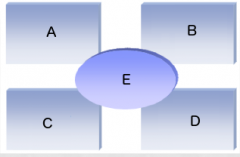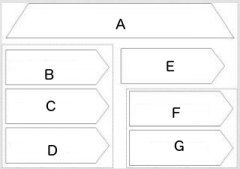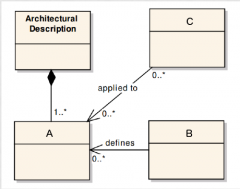![]()
![]()
![]()
Use LEFT and RIGHT arrow keys to navigate between flashcards;
Use UP and DOWN arrow keys to flip the card;
H to show hint;
A reads text to speech;
79 Cards in this Set
- Front
- Back
|
What are the 6 levels of Architecture |
The 6 levels of architecture are:
|
|
|
Enterprise architecture |
|
|
|
Software architecture |
Software architecture is high-level requirements & design of a software system |
|
|
What are the 4 layers in the Enterprise view |
the 4 layers in the enterprise view are:
|
|
|
Describe the steps in the TOGAF model |
Preliminary phase: Frameworks & Principles A: Architecture Vision B: Business Architecture C: Information Systems Architecture D: Technology Architecture E: Opportunities and Solutions F: Migration Planning G: Implementation Governance H: Architecture Change Management
|
|
|
What is the ISO/IEC/IEEE defenition of Architecture ? |
(System) fundamental concepts or properties of a system in its environment embodied in its elements, relationships, and in the principles of its design and evolution |
|
|
Why use an Architecture ? |
|
|
|
How do requirements relate to architecture |
requirements are an input to architecture they frame the architectural problem. An architecture is a framework for evaluating requirements |
|
|
What is the relationship between architecture and design |
architecture frames design, architecture is part of the design process but not all design is architectural. |
|
|
What is an Architectural Description (AD)? |
An architectural description (AD) is a set of products which documents an architecture in a way which is understandable by its stakeholders. |
|
|
What products are present in an Architectural Description (AD) ? |
the products in an architectural description (AD) include:
|
|
|
How detailed should an Architectural Description(AD) be ? |
the architectural description (AD) should show the overall picture, but also decompose into enough detail. |
|
|
What are some of the challenges in creating an Architectural Description(AD) ? |
some of the challenges in creating an Architectural Description(AD) are:
|
|
|
name 4 structures that can be defined by an Architecture |
|
|
|
What are some challenges when dealing with many structures ? |
|
|
|
What is the difference between an Architectural View and a view ? |
none, they are synonyms for the same thing. |
|
|
Give the definition of an Architectural View |
An architectural view is a representation of the whole system, as seen through the prism of specific concerns. |
|
|
Why is it wise to create multiple views instead of a single model ? |
it is impossible to describe a software architecture by using a single model. such a model is hard to understand and is unlikely to clearly identify the architecture’s most important features. It also tends to poorly serve individual stakeholders because they struggle to understand the aspects that interest them. |
|
|
which of the following statements is correct
|
only statement 2 is correct
A view consists of one OR more models that represent it |
|
|
Which of the following statements are incorrect
|
statement 1 and statement 2 are incorrect.
a viewpoint is a pattern or generalization of a view
the viewpoint is the class (or template), the view is the instance |
|

Provide the missing keywords for A, B, C in the following diagram about Architectural Descriptions. |
A = Architectural Description B = View C = Viewpoint |
|
|
What are the 5 views in the Rup / Kruchten 4+1 model ? |
1. Logical View 2. Implementation View 3. Use-case View 4. Process View 5. Deployment View |
|
|
What can be said about the Quality attributes in the RUP/Kruchten 4+1 model ? |
Quality attributes are less explicit in the RUP/Kruchten 4+1 model |
|

Fill in the missing keywords in this diagram of the RUP/Kruchten 4+1 model |
A = Logical View B = Implementation View C = Process View D = Deployment View E = Use-Case View |
|
|
Give a short description for each View in the Rup/Kruchten 4+1 model |
|
|
|
The Rup/Kruchten 4+1 model is:
a) rather technically oriented b) rather focused on the users of the system |
A |
|
|
What is another name used for Physical View ? |
Deployment View |
|
|
What is another name used for Scenarios in the RUP/Kruchten 4+1 model ? |
Use-Case View |
|
|
Give the definition of a Viewpoint |
A viewpoint is a collection of patterns, templates, and conventions for constructing one type of view. It defines the stakeholders whose concerns are reflected in the viewpoint and the guidelines, principles and template models for constructing its views. |
|
|
list the viewpoints of the Rozanski & Woods viewpoint set. |
|
|
|
Which of the following statements is/are correct:
1. The R&W viewpoint set is an extension and refinement of the Kruchten's set. 2. The Viewmodel of Rozanski & Woods is aimed at old, large scale and distributed information systems. |
Only Statement 1 is correct.
The Viewmodel of Rozanski & Woods is aimed at new, large scale and distributed information systems. |
|

Fill in the missing keywords in this diagram of the Rozanski & Woods viewpoint set. |
A = Context Viewpoint B = Functional Viewpoint C = Information Viewpoint D = Concurrency Viewpoint E = Development Viewpoint F = Deployment Viewpoint G = Operational Viewpoint |
|
|
What is the definition of Quality Properties |
Quality Properties are the non-functional characteristics of the system. |
|
|
list 5 examples of Quality Properties |
|
|
|
Give some reasons why quality properties are crucial to stakeholders |
|
|
|
what is the definition of Perspectives ? |
A perspective is a collection of patterns, templates and guidelines to ensure the system has the right quality properties |
|
|
What is the focus, result and guidance of a Viewpoint ? |
Focus: a type of structure Result: a view - model(s), a primary arch structure Guidance: models to create, advice based on practice |
|
|
What is the focus, result and guidance of a Perspective ? |
focus: a quality property Result: changes to views, supporting artifacts Guidance: a process for application, advice based on practice. |
|
|
is the following statement correct ?
"You apply perspectives to the architecture to ensure quality properties are acceptable and guide it's development" |
Yes |
|

Fill in the missing keywords on positions A,B,C |
A = View B = Viewpoint C = Perspective |
|
|
In order to describe a perspective several aspects need to be elaborated on. What are those aspects ? |
|
|
|
What is an Architectural tactic |
an architectural tactic is an established approach or solution you can use to achieve a particular quality property (QP) |
|
|
how does one apply architectural tactics ? describe the 4 steps that need to be completed in order to do so. |
|
|
|
list the core perspectives |
|
|
|
what are the concerns of the Performance and Scalability perspective ? |
the concerns of the Performance and Scalability perspective are:
|
|
|
What are the tactics of the Performance and Scalability perspective ? |
the tactics of the Performance and Scalability perspective are:
|
|
|
What are the concerns of the Security perspective ? |
|
|
|
What are the tactics of the Security perspective ? |
|
|
|
What are the concerns of the Availability and Resilience perspective |
|
|
|
What are the tactics of the Availability and Resilience perspective ? |
|
|
|
What are the concerns of the Evolution perspective |
|
|
|
What are the tactics of the Evolution perspective |
|
|
|
what are the two questions that need to be answered before applying a perspective |
|
|
|
is the following statement correct ?
an architectural pattern often implements multiple tactics, usually related to different qualities, in a coherent way |
yes |
|
|
What is the definition of an architectural tactic ? |
an architectural tactic is an established approach or solution you can use to achieve a particular quality property (QP) |
|
|
What are the 3 levels of software patterns ? |
|
|
|
Give an example for each level of software pattern |
|
|
|
What are the 3 pattern categories ? |
|
|
|
Give a description of each pattern category |
|
|
|
Give an example of each pattern category |
|
|
|
What is the definition of an architectural element ?
|
an architectural element is a clearly identifiable, architecturally meaningful piece of a system
|
|
|
What is the definition of a stakeholder ?
|
a stakeholder is a person, group or entity with interest in or concerns about the realization of the architecture.
|
|
|
Give a short description of the context viewpoint in the R & W viewpoint set.
|
the context viewpoint describes the relationships, dependencies and interactions between the system and it's environment
|
|
|
Give a short description of the functional viewpoint in the R & W viewpoint set
|
the functional viewpoint describes the system's run time functional elements, their responsibilities, interfaces, and primary interactions
|
|
|
Give a short description of the information viewpoint in the R & W viewpoint set
|
the information viewpoint describes the way that the system stores, manipulates, manages, and distributes information
|
|
|
Give a short description of the concurrency viewpoint in the R & W viewpoint set
|
the concurrency viewpoint describes the concurrency structure of the system and maps functional elements to concurrency units to clearly identify the parts of the system that can execute concurrently and how this is coordinated and controlled.
|
|
|
Give a short description of the development viewpoint in the R & W viewpoint set
|
the development viewpoint describes the architecture that supports the software development process.
|
|
|
Give a short description of the deployment viewpoint in the R & W viewpoint set
|
the deployment viewpoint describes the environment into which the system will be deployed and the dependencies that the system has on elements of it.
|
|
|
Give a short description of the operational viewpoint in the R & W viewpoint set
|
the operational viewpoint describes how the sytem will be operated, administered, and supported when it is running in its production environment.
|
|
|
List the stakeholders of the Logical view in the RUP/Kruchten 4+1 view model
|
the stakeholders of the logical view are:
- acquirers - end users - developers - maintainers of the system |
|
|
List the stakeholders of the Implementation view in the RUP/Kruchten 4+1 view model
|
the stakeholders of the implementation view are:
- developers - software management - configuration management |
|
|
List the stakeholders of the process view in the RUP/Kruchten 4+1 view model
|
the stakeholders of the process view are:
- acquirers - developers - maintainers - system integrators |
|
|
List the stakeholders of the deployment view in the RUP/Kruchten 4+1 view model
|
the stakeholders of the deployment view are:
- acquirers - system engineers |
|
|
List the stakeholders of the Use-Case view in the RUP/Kruchten 4+1 view model
|
the stakeholders of the Use-Case View are:
- users of the system - acquirers - developers |
|
|
What are the deliverables of the Logical View in the RUP/Kruchten 4+1 model. |
The deliverables of the Logical View are:
|
|
|
What are the deliverables of the Implementation View in the RUP/Kruchten 4+1 model? |
The deliverables of the implementation view are:
|
|
|
What are the deliverables of the Process View in the RUP/Kruchten 4+1 model? |
the deliverables of the Process view are:
|
|
|
What are the deliverables of the Deployment View in the RUP/Kruchten 4+1 model? |
the deliverables of the Deployment view are:
|
|
|
What are the deliverables of the Use-case view in the RUP/Kruchten 4+1 model? |
the deliverables of the Use-case view are:
|

